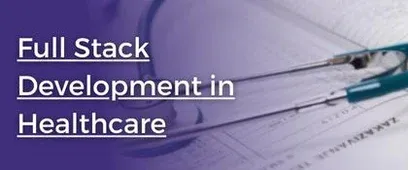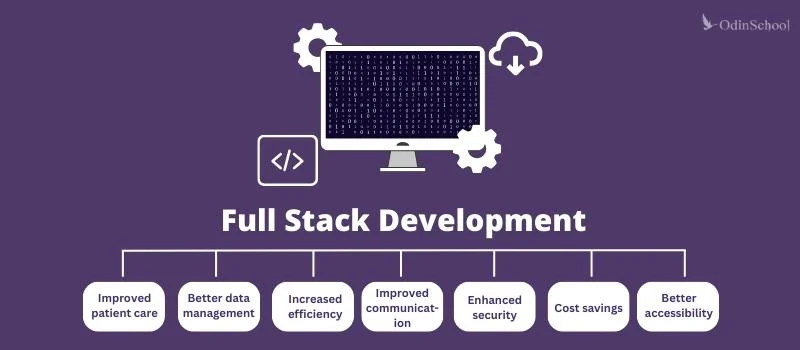Why Full Stack Development is Essential for the Healthcare Industry

In its continual quest to protect and enhance our quality of life, humanity has reached a tipping point. Healthcare has long since entered a phase of rapid transformation. Now, how is Full Stack Development transforming the healthcare industry?
One of the numerous forces driving patient empowerment, which is profoundly altering how we prevent, diagnose, and treat diseases, is longevity and the development of new technologies and scientific discoveries, as well as creative combinations of already existing ones.
Technology Reigns
The healthcare system has already been altered by wearables, mHealth, telemedicine, and digital health technologies, and this transformation will continue in the years to come.
Artificial intelligence, currently among the most widely used technology in healthcare, is what's driving this transition.
In 2023, the market for artificial intelligence, particularly machine learning technologies, will exceed $20 million. Not only ML (Machine Learning), but also other AI (Artificial Intelligence) technologies will continue to be adopted as their usefulness and value continue to bear witness. Examples of these technologies include natural language processing, computer vision, pattern recognition algorithms, and predictive analysis. By 2030, this market will be worth $187.95 billion. AI is used in healthcare on a daily basis for everything from finding new medicine combinations to treating neurological problems to organizing medical information.
Why Do We Need Full Stack Development
Generally, the engineering teams end up handling network infrastructure, and managing databases. It takes time to comprehend all of these new technologies thoroughly and practically. However, Full Stack programmers can also do these and are remarkably flexible and can easily move between front-end and back-end code.
Furthermore, it has become even more difficult with the development of AI and machine learning, predictive computing, and adaptable design. So, full stack engineers are generally familiar with the entire technology stack to quickly and effectively build an end-to-end application.
What is Full Stack Development, and how do you become one in 2023?
Full Stack Development in Healthcare
Given the hyper-personalization today, the healthcare industry needs secure and frictionless development. Also, the systems need to be trained on a lot of high-quality data in order to be able to produce predictions and suggestions that are correct.
The amount of data currently available to the healthcare sector is tremendous, and not all of it is structured and secure. The primary benefit of a complete stack is its inherent connection to security. While crucial to many fields, security is particularly necessary for healthcare, where patient privacy is of highest concern. There have been many cyber-attacks - Healthcare data breaches cost an average of $408 per record, which is three times higher than the cross-industry average.
Due to the fundamental nature of full-stack, apps must make every effort to maintain their security, from the app level to the network itself. Leadership and administration, security, and IT teams must all collaborate to agree on a plan and the tools required for hospital or clinic operations to run smoothly and securely.
This contrasts with traditional methods, in which security and IT teams frequently work in isolation, with little interaction between them, and with IT concentrating on performance and security on fixing vulnerabilities.
These teams can successfully interact to put in place a system that is ready to withstand more dangerous ransomware attacks when full-stack and business contexts are merged.
Why is Full Stack Needed in Healthcare?

Full stack development has several benefits for the healthcare industry. Here are some of the top benefits of using full stack development in healthcare:
- Improved patient care: Full stack development enables the creation of user-friendly, secure, and scalable healthcare applications that healthcare providers can use to manage patient care. With these applications, healthcare providers can easily access patient data, track patient progress, and communicate with other healthcare providers to improve patient outcomes.
- Better data management: Full stack development enables the creation of databases and APIs that can handle large volumes of patient data. This makes it easier for healthcare providers to manage patient data, analyze patient data, and make data-driven decisions.
- Increased efficiency: Full stack development enables the creation of applications that automate manual processes, such as patient registration, scheduling appointments, and billing. This can save healthcare providers time, reduce administrative costs, and improve the overall efficiency of healthcare operations.
- Improved communication: Full stack development enables the creation of communication tools that healthcare providers can use to communicate with patients, other healthcare providers, and healthcare organizations. This can improve the coordination of care, reduce errors, and improve patient outcomes.
- Enhanced security: Full stack development enables the creation of applications that are secure and compliant with healthcare regulations such as HIPAA, GDPR, and HITECH. This can protect patient data, prevent data breaches, and improve patient trust in healthcare providers.
- Better accessibility: Full stack development enables the creation of applications that are accessible to patients with disabilities or who have limited access to healthcare services. This can improve patient access to care and reduce healthcare disparities.
- Cost savings: Full stack development can reduce the cost of healthcare by improving the efficiency of healthcare operations, reducing administrative costs, and improving patient outcomes. This can help healthcare providers deliver high-quality care at a lower cost.
Overall, full stack development can help healthcare providers deliver high-quality care to their patients.
Top Healthcare Use-Cases with Full Stack
Full Stack benefits healthcare in many ways (we have already seen it). Here are some of the top use cases of using full stack development in healthcare:
- Electronic Health Record (EHR) Systems: EHR systems are digital records of patient health information. Full stack developers work on both the front-end and back-end of the EHR system to ensure that it is user-friendly, secure, scalable, and compliant with healthcare regulations. They also have to ensure that the system is very reliable.
- Patient Portals: Patient portals provide patients with access to their health information, enabling them to communicate with healthcare providers, schedule appointments, and manage their healthcare. Full stack developers can build patient portals that are user-friendly, secure, and that integrate with other healthcare systems.
- Healthcare Analytics: Healthcare analytics software can analyze large volumes of healthcare data to identify trends, patterns, and insights. Full stack developers can build healthcare analytics software that supports data visualization, predictive analytics, and real-time data analysis.
- Health Information Exchange (HIE) Systems: HIE systems enable the exchange of patient health information between different healthcare providers and systems. Full stack developers can build HIE systems that ensure data privacy and security, and that integrate with other healthcare systems.
- Mobile Health (mHealth) Applications: mHealth applications are mobile apps that enable patients to manage their healthcare from their mobile devices. Full stack developers can build mHealth applications that support remote monitoring, appointment scheduling, medication tracking, and more.
Future of Full Stack Development in Healthcare

Below are a few predictions for the future of healthcare,
- Patient engagement: The design of patient engagement tools that motivate patients to actively participate in their own health management will be made possible by full stack development. More applications made by full stack developers will provide patients access to their own medical records, let them communicate with medical professionals, and offer them educational materials to help them manage their health.
- Precision medicine: Full stack development will enable the creation of precision medicine solutions that tailor treatments to individual patients. Full stack developers will create more applications that use patient data to identify personalized treatment options, predict patient outcomes, and monitor patient progress.
- Remote monitoring: Full stack development will enable the creation of remote monitoring solutions that enable healthcare providers to monitor patient health outside of traditional healthcare settings. Full stack developers will create more applications that use wearable technology to collect patient data, analyze patient data, and alert healthcare providers when patients need attention.
- Telemedicine: Full stack development will enable the creation of telemedicine solutions that provide patients with remote access to healthcare providers. Full stack developers will create applications that enable patients to communicate with healthcare providers through video conferencing, secure messaging, and other communication channels.
- Patient safety: Full stack development will enable the creation of patient safety solutions that reduce the risk of medical errors and adverse events. Full stack developers will create more applications that use patient data to identify potential risks, provide healthcare providers with alerts and reminders, and track patient progress to ensure that patients receive appropriate care.
Final Thoughts
While there is no ideal answer, full-stack with business context gives the best path ahead for healthcare companies to function well in the future as it becomes more digital.
Healthcare IT should take into account this solution to improve team communication, ensure customer security, and prevent potential issues before they ever affect end users, given the already high percentage of consumers who expect flawless app performance and the increasing stakes of performance issues.
OdinSchool has an excellent curriculum for its Full Stack Developer Course that concentrates primarily on providing hands-on experience on live industry-related projects. We have SMEs available 24x7. If you want to be at the forefront of technological advancements, now is the right time to get started!